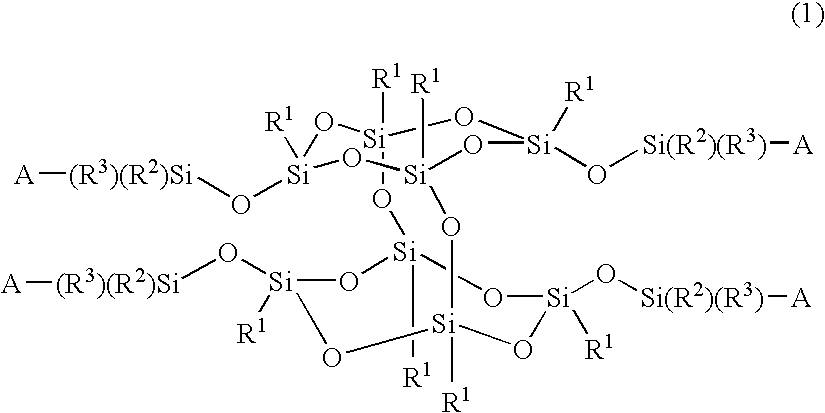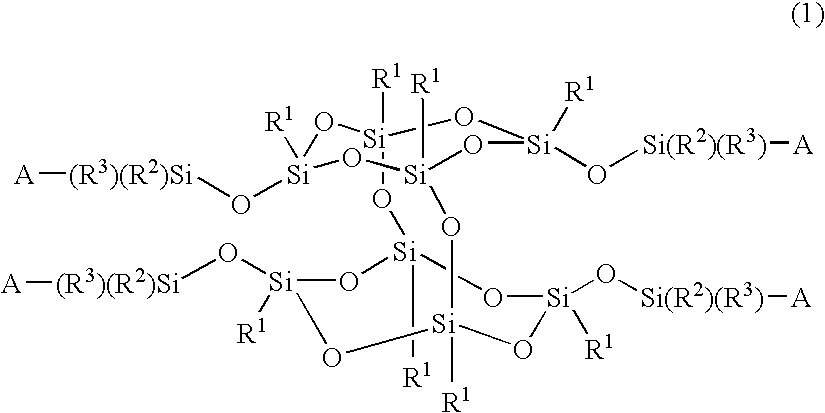Silicon compound
a technology of compound and living radical, applied in the field of new materials, can solve the problems of difficult control of structure, inability of organic composite materials to do so, etc., and achieve the effect of excellent living radical polymerization initiating function and excellent living radical polymerization accelerating function
- Summary
- Abstract
- Description
- Claims
- Application Information
AI Technical Summary
Benefits of technology
Problems solved by technology
Method used
Image
Examples
example 1
[0295]A reactor having a content volume of 50 liter equipped with a reflux condenser, a thermometer and a stirrer was charged with phenyltrimethoxysilane (6.54 kg), 2-propanol (26.3 liter), purified water (0.66 kg) and sodium hydroxide (0.88 kg) and sealed with dry nitrogen. The reactor was heated while heating to react them for 5 hours in a refluxing state. After finishing the reaction, the heater was detached from the reactor, and this vessel was left standing at room temperature for 15 hours to cool the reaction mixture. A supernatant was removed from the reaction mixture thus obtained by decantation.
[0296]Then, a white solid matter remaining in the reactor was washed once with 2-propanol (9.87 kg). This was transferred into a stainless bat lined with a polytetrafluoroethylene sheet and dried at an inner temperature of 80° C. and a pressure of 6.7×10−4 MPa for 24 hours by means of a dryer under reduced pressure to obtain 2.22 kg of a white powder-like compound (A-1).
example 2
[0297]A four neck flask of 50 ml equipped with a reflux condenser was charged with the compound (A-1) (1.2 g), tetrahydrofuran (10 g) and triethylamine (1.6 g) and sealed with dry nitrogen. Trimethylchlorosilane (2.2 g) was dropwise added thereto in about one minute while maintaining a solution temperature at 15 to 20° C. under stirring by means of a magnetic stirrer. After finishing dropwise adding, stirring was continued at 15° C. for 3.5 hours. After finishing the reaction, the reaction product was washed with purified water and dried under vacuum to obtain a white solid matter (1.2 g). This is designated as a compound (A-T).
[0298]The compound (A-T) was subjected to structural analysis by means of gel permeation chromatography (GPC), 1H-NMR and 29Si-NMR. It was confirmed from a GPC chart that the white solid matter showed monodispersibility and that it had a number average molecular weight of 970 and a weight average molecular weight of 990 in terms of polystyrene. It was confirm...
example 3
[0300]A four neck flask having a content volume of 1000 ml equipped with a dropping funnel, a thermometer and a reflux condenser was charged with a rotator, the compound (3-1-1) (69 g) obtained by making use of the method in Example 1 and toluene (540 g), and the flask was sealed with dry nitrogen. Dimethylchlorosilane (9.1 g) was dropwise added thereto from the dropping funnel in about 35 minutes while stirring by means of a magnetic stirrer. In this case, the dropping speed was controlled so that the solution temperature was 25 to 35° C. After finishing dropwise adding, the flask was heated while stirring, and stirring was continued in a refluxing state for 3 hours to complete the reaction. After finishing the reaction, the flask was left cooling so that the solution temperature was lowered down to 50° C. or lower. Then, 160 g of purified water was slowly dropwise added thereto from the dropping funnel. After finishing dropwise adding, the solution was stirred for about 10 minutes...
PUM
| Property | Measurement | Unit |
|---|---|---|
| temperature | aaaaa | aaaaa |
| temperature | aaaaa | aaaaa |
| temperature | aaaaa | aaaaa |
Abstract
Description
Claims
Application Information
 Login to View More
Login to View More - R&D
- Intellectual Property
- Life Sciences
- Materials
- Tech Scout
- Unparalleled Data Quality
- Higher Quality Content
- 60% Fewer Hallucinations
Browse by: Latest US Patents, China's latest patents, Technical Efficacy Thesaurus, Application Domain, Technology Topic, Popular Technical Reports.
© 2025 PatSnap. All rights reserved.Legal|Privacy policy|Modern Slavery Act Transparency Statement|Sitemap|About US| Contact US: help@patsnap.com



